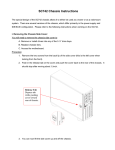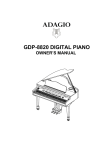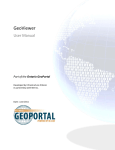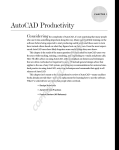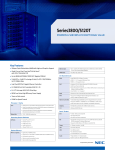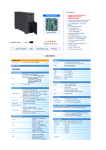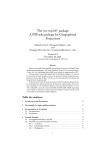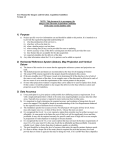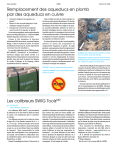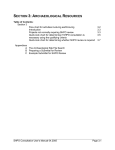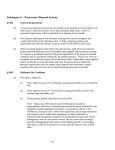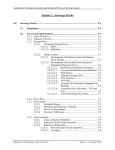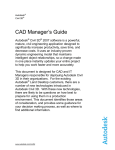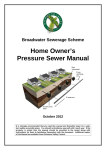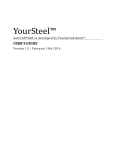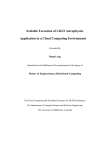Download Constructed Asset Data Submission Manual
Transcript
City of Kitchener Infrastructure Services Department Engineering Services Constructed Asset Data Submission User Manual for Engineering Revised: February 1, 2013 City of Kitchener Constructed Asset Data Submission User Manual for Engineering Revision History Revision Description Initial Draft for Review Final Draft Revisions Requirements Updates Tracking Form revisions Tracking Form revisions Requirements Updates Tracking Form revisions User Manual revisions FAQ Updates User Manual revisions Template revisions Date September 10, 2010 September 13, 2010 Dec 14, 2010 September 29, 2011 March 15, 2012 October 2, 2012 October 2, 2012 October 2, 2012 November 29, 2012 February 1, 2013 February 1, 2013 2 City of Kitchener Infrastructure Services Department Engineering Services Constructed Asset Data Submission User Manual for Engineering Table of Contents 1.0 BACKGROUND................................................................................................................................. 4 2.0 CONSTRUCTED ASSET DATA DEFINITIONS .......................................................................... 4 3.0 Before you Begin ............................................................................................................................. 5 Constructed Asset Data submission requirements pertain to all Site Plans, Subdivisions, New Construction, and Reconstruction Projects............................................................................. 5 * Refer to Appendix C for complete instructions on submitting drawings in Spatial Data File Format (SDF) ..................................................................................................................... 5 4.0 Constructed Asset Tracking form .............................................................................................. 5 4.1) Version Updates tab .................................................................................................................. 5 4.2) Overview tab................................................................................................................................ 5 4.3) Recording Asset Information.................................................................................................. 6 4.4) Data Entry..................................................................................................................................... 7 4.4.1) Instructions .............................................................................................................................. 7 4.4.2) Default Values.......................................................................................................................... 8 4.4.1) Services/Valves/Infiltration Galleries ................................................................................ 9 4.4.1) Culverts/Bridges ..................................................................................................................... 9 6.0 Requirements for Approval ........................................................................................................ 10 APPENDIX A .......................................................................................................................................... 11 Constructed Assets Data Submission FAQ ....................................................................................... 11 APPENDIX B .......................................................................................................................................... 17 Drawing Examples ................................................................................................................................. 17 APPENDIX C .......................................................................................................................................... 21 Constructed Asset Data (SDF) Format ............................................................................................... 21 City of Kitchener Constructed Asset Data Submission User Manual for Engineering 1.0 BACKGROUND In 2010, data submission requirements have been further defined as part of the City of Kitchener Development Manual. All City of Kitchener owned infrastructure assets must be reported, along with both public and privately owned storm water facilities (i.e., Ponds, Infiltration Galleries, Oil and Grit Separators). In supplement to “As Recorded” drawings, a separate AutoCAD file, called the “Constructed Assets Drawing” and Constructed Asset Data Tracking form (MS Excel spreadsheet) must be completed and submitted in a CD to respective Engineering staff. Commencing March 2013, AutoCAD drawings in the City’s Spatial Data Format (SDF) should be submitted. All form areas must be complete if corresponding infrastructure was constructed, with the exception of bridges or culverts 3m or greater, which will require an Ontario Structure Inspection Manual (OSIM) standard form (pages 1 and 4 only). The Consultant shall refer to the Development Manual webpage to download the latest forms, manuals, and frequently asked questions. Once approved all digital copies are to be delivered to GIS by Engineering staff for final processing. Link to Development Manual Webpage: http://kitchener.ca/en/businessinkitchener/Development_manual.asp 2.0 CONSTRUCTED ASSET DATA DEFINITIONS As-Recorded Drawing: refers to digital CAD drawing that contains all built information as per design. Constructed Asset Drawing: refers to the digital CAD drawing that contains all constructed infrastructure. Refer to the Overview tab in the tracking form for CAD layer names, Graphic Types, Block Names, and Infrastructure ID requirements. All constructed assets in the drawing must have an Asset ID to correspond to the IDs laid out in the tracking form. Culvert: an asset that conveys open surface water features to open surface water features perpendicular to the roadway. See Appendix A. Inlet: an asset that feeds into a closed network from a storm water facility regardless if it is a catch basin. See Appendix A. Outlet: an asset that terminates into open watercourse (i.e. ponds, ditches, creeks). See Appendix A. 4 City of Kitchener Constructed Asset Data Submission User Manual for Engineering SDF: Spatial Data file format for Autodesk GIS programs. Submitting constructed asset data in this format reduces the need for the Excel spreadsheet. All asset information is attached to each of the layers in the drawing. Storm Service: an asset that moves storm water from private to public property, even if there is a manhole at the main connection to private property. See Appendix A. Storm/Sanitary Pipe: an asset responsible for main network conveyance from manhole to manhole. See Appendix A. 3.0 Before you Begin Constructed Asset Data submission requirements pertain to all Site Plans, Subdivisions, New Construction, and Reconstruction Projects. Refer to Appendix C for complete instructions on submitting drawings in Spatial Data File Format (SDF) The SDF drawing completely replaces the previous method, which included an Excel tracking form and simplified CAD drawing. Previous methods will be accepted until March 2013. Version 2.0 has merged tracking forms for Site Plans and for Subdivisions, New Construction, and Reconstructions: Kitchener_Constructed-Asset_Tracking_Form_V2003.xls (version 2003 only) Kitchener_Constructed-Asset_Tracking_Form_V2010.xlsm (version 2007/2010 only) 4.0 Constructed Asset Tracking form 4.1) Version Updates tab The version tab is used to show users a list of changes that were made to the tracking form. It also confirms that the user has the most current version, which should be the same as what is currently posted on the webpage. 4.2) Overview tab The overview tab is a guide for submission requirements for approval. As information is entered into the form the “Incomplete” column will light up in red until all required information is filled out. Once data entry is complete the “Complete” column will light up in green. Consultants can review this tab before submitting to ensure completeness. City of Kitchener Project Managers can use this tab as a first check in approving submissions, along with their quality assurance and quality control (QA/QC) checks. 5 City of Kitchener Constructed Asset Data Submission User Manual for Engineering Figure 1: Overview Tab in the Asset Data Tracking From (MS Excel). The Constructed Assets CAD drawing must use the infrastructure IDs that are laid out in the form. Refer to the “Overview” Tab in the Asset Tracking form. In the overview tab of the form, sections must show as complete before submitting. 4.3) Recording Asset Information Information should contain proposed infrastructure within the right of way (or up to property line), with the exception for Stormwater Management Facilities: Ponds, Infiltration Galleries, and OGS units. ALL SWM Facilities both private and publicly owned must be documented (for the Kitchener SWM Audit). Installation dates must be filled out if construction will not be completed by City forces. For subdivisions, sidewalk installation dates can be left blank on the form, and will coincide with the date of final acceptance. For site plans, all installation dates can be left blank. 6 City of Kitchener Constructed Asset Data Submission User Manual for Engineering 4.4) Data Entry 4.4.1) Instructions There are 8 worksheet tabs in the form, which corresponds to each layer in the Overview tab. At the top left corner of each tab there are specific data entry instructions, see Figure 2. Instructions: ALL new infrastructure within the City of Kitchener Right - of - Way must be identified in this form and correspond to as-recorded drawings submissions via the bolded "ID" (e.g. Benchmark ID) For Data Entry Drop-Down Selection Calculated, Not For Data Entry Figure 2: Monumentation Tab Instructions. Throughout the form there are helpful tips, look for a red triangle as shown in Figure 3: Figure 3: Comment boxes provide helpful tips where you see a red triangle. Areas that are highlighted in blue are automatically calculated and filled in based on a previous selection, See Figure 4. 7 City of Kitchener Constructed Asset Data Submission User Manual for Engineering Figure 4: Drop down selection under the road tab, auto-populates thickness values based on standard road profiles. 4.4.2) Default Values In more common projects, some areas have been set to default values to assist in data entry. If these values should differ, there is the ability to change or over-write the default. In Figure 5, most sidewalks will not be combined with stairs, railings, or bike paths so the default value is set to “NO.” Similarly, we can assume most sidewalk materials are concrete. Figure 5: Default values to assist in data entry. 8 City of Kitchener Constructed Asset Data Submission User Manual for Engineering 4.4.1) Services/Valves/Infiltration Galleries For services (sanitary, water, storm), infiltration galleries, valves, anodes, hydrants, chambers, casing, and other water point features you may indicate if the information filled out in SASR1 can be applied to a number of other services. This will reduce data entry (See Figure 6). However, if there are variations in services the following columns must be filled out (SASR2, SASR3…) and the proper infrastructure IDs must be noted in the drawing. Figure 6: Applying identical information for all sanitary services. The same concept applies to water and storm services. 4.4.1) Culverts/Bridges If the internal diameter of a storm culvert is 3000mm or greater then it is considered a bridge. A bridge inspection must be completed in accordance to the Ontario Structural Inspection Manual (OSIM), see Figure 7. Page 1 to be completed per bridge and Page 4 to be completed per bridge element. Forms can be saved by printing to PDF. Figure 7: Every time the internal diameter cell is clicked on a bridge criteria message will appear. 9 City of Kitchener Constructed Asset Data Submission User Manual for Engineering 6.0 Requirements for Approval As stated previously: Commencing March 2013, AutoCAD drawings in the City’s Spatial Data Format (SDF) should be submitted. For Site Plans, Constructed Asset Data Drawings must be submitted as part of the Site Plan Approval Process. For Reconstruction and New Construction projects, Constructed Asset Data Drawings must be submitted no later than 3 months following Substantial Performance. For Subdivisions, Constructed Asset Data Drawings must be submitted within 3 months of initial acceptance. If any information from any submission is incorrect or incomplete the City reserves the right to reject the submission and the Subdividers shall be required to resubmit the corrected submission prior to acceptance of the Maintenance Package. 10 City of Kitchener Constructed Asset Data Submission User Manual for Engineering APPENDIX A Constructed Assets Data Submission FAQ 1.0 2.0 3.0 4.0 5.0 6.0 7.0 8.0 General Benchmark Bridge/Cuvlert Road Sidewalk Stormwater/Groundwater Sewer System Sanitary Sewer System Water System 1.0 General How should I refer to the documents required for the data submission? The digital AutoCAD drawing is called the Constructed Asset Drawing. See Appendix B and C. The digital excel form is referred to the Constructed Assets Tracking Form. See figure 1 in the Constructed Asset Tracking Form Manual What is the difference between the As-Recorded drawing and the Constructed Asset Drawing? The as-recorded drawing shows everything proposed and constructed, and does not need to be done in City layer and CAD standards. The constructed asset drawing must use City layer name standards and must be drawn to City standards. The constructed asset drawing is used for the purpose of importing information into our Geographic Information Systems (GIS). Refer to individual infrastructure sections in Appendix A for further details. In which UTM coordinate system (ground or grid) should the Constructed Assets drawing be provided? Grid. For ‘As-Recorded’ drawing submissions, when translating the drawing to UTM NAD 83 Zone 17 coordinates, is it sufficient to get the UTM coordinates from Google Earth or OBM Mapping? What does the accuracy need to be? Or does the City have UTM coordinates (mapping) available for the City? Or do we need to use GPS to get the most accurate coordinates? It should be GPS or surveyed and translated to UTM NAD 83 Zone 17 coordinates. If the project is a reconstruction and the consultant is working for the city we can provide Teranet land parcel information. If it is a subdivision they do have the option of purchasing the land parcel from Teranet but we cannot provide the data as part of our 3rd party agreement. Accuracy should be to the POLARIS standard. 11 City of Kitchener Constructed Asset Data Submission User Manual for Engineering Would the City consider using AIA National CAD standards? At this time, no. The City currently has a layering system in place that is familiar to internal and some external stakeholders. Plotting – Color dependent vs. Name dependent? For development projects (i.e. site plans, subdivisions) this is irrelevant. Capital and development charge projects should be name dependent as per the supplied file on the website. Are consultants required to use the City’s standard layers and blocks for the As-Recorded Drawing? These are not required for this drawing. Does a separate digital constructed assets watermain drawing need to be provided to Kitchener Utilities? No, the As-Recorded watermain ties and information drawing can be combined with the As-Recorded and Constructed Assets drawings. Is the Consultant required to complete field surveys in City layers? No, the Consultant may proceed through the data collection and design stage using their layer standards. Who at the City is creating and maintaining Civil3D standards and styles? The Design and Approvals Section within the Engineering Division retains this task. How do I know I have the latest version of the tracking form? The latest version will always be available for download on the City of Kitchener’s website. Where can I find the Constructed Assets Form and Manual? On the City’s website at: http://www.kitchener.ca/en/businessinkitchener/Development_manual.asp How can I get parcel fabric data? If the consultant is doing a Capital Works project for the City, City (GIS) will provide Teranet information (property fabric) as requested. If the project is development related, consultant must contact Teranet to purchase land Parcels the city is under a 3rd party agreement with Teranet and can not resell their data. How much lot fabric do I need to show in the assets drawing? The amount of lot fabric required is such that the assets drawing can be verified to match the City’s parcel fabric. The minimum acceptable amount of lot fabric would be the limits of the road right-of-way. 12 City of Kitchener Constructed Asset Data Submission User Manual for Engineering Can I submit a shapefile instead of the assets drawing and tracking form? Currently the City does not accept submissions of the Constructed Assets drawing in shape file format. Another format we are accepting is a Spatial Data File (SDF), which can be created using AutoCAD Civil 3D or AutoCAD with Map3D. This removes the need to use the MS Excel spreadsheet and attach asset information to individual assets in the drawing. Refer to section 5.0 of the Constructed Asset Tracking Form Manual. What font properties should the asset ID labels have? ID labels should be text objects and are preferred to be center justified and placed on the insertion point (or centre) of the structure. The recommended text size is 0.8 units. Should ID labels be on one text layer or one text layer per asset layer? Either way is acceptable as long as all id text fit well together and is legible. Which drawing needs to have the asset IDs in order to match the Asset tracking form? Only the Constructed Assets drawing is required to have asset IDs, the As-Recorded drawing does NOT require asset ID’s. Site Plans do not have constructed assets, what should I do? Constructed Assets drawings for Site plans should include any proposed service connections within the right of way and ALL stormwater facilities, OGS, and infiltration galleries on site (for the purpose of either quantity or quality). Refer to section 4.3 of the Constructed Asset Tracking Form Manual. When am I required to submit the Constructed Assets drawing and tracking form? This data submission is required prior to the first letter of credit reduction, as outlined in Section A.9.4 of the Development Manual. If there are styles with layers attached, they will not purge out, should all of the styles and extra layers be purged on the template? We are informing our reviewers that there may be extra layers and that it is ok, as long as the data in relevant layers are correct. This will be considered in future updates to the template. When importing the data from C3D to the drawing you are using the outer diameter and not the inner diameter. Does the outer diameter not have the wall thickness? And this will give the incorrect data? Any diameter figures will be referenced as an inner diameter. Should we not be importing the manhole numbers and pipe numbers, there is no way to tell the consultant which manhole or pipe has issues without this. This is not necessary, eventually the automatic CAD checker will provide a visual report of any issues within the drawing. 13 City of Kitchener Constructed Asset Data Submission User Manual for Engineering If the information is from C3D and there is another field inside the table do we need to fill in the table? No, our process will be able to pick up information that comes from C3D so you can leave the one in our table blank. 2.0 Benchmark When do you require geodetic benchmark information? Geodetic benchmark information is not required in the spreadsheet, unless there are new benchmarks installed as a part of the work that the consultant has undertaken through the design process. 3.0 Bridges/Culverts How are bridges / culverts to be drawn in the Constructed Assets Drawing? The centerline of the bridge / culvert should be used to represent this feature. The centerline for bridges will be drawn parallel to the span of the bridge, for culverts the centerline will be drawn perpendicular to the span of the culvert. Where do I provide Constructed asset data for a bridge or a culvert with a span of 3m or greater? New bridges require pages 1 and 4 of the Ministry of Transportation’s Ontario Structure Inspection Manual (OSIM) to be filled out. A copy of page 4 needs to be filled out for each bridge element, e.g. abutments, deck, approaches, railings. 4.0 Road What is required to be shown in the Constructed Assets drawing for roads? The edge of pavement, curbs and road centreline shall be shown. Where road widths vary the average width shall be used. This is to be drawn from intersection to intersection. 5.0 Services How will services with different material types or some other attribute be differentiated? 14 City of Kitchener Constructed Asset Data Submission User Manual for Engineering The Asset ID labels will differentiate between different types of services. E.g. If there are 100 water services, 80 of them that are 25mm copper could all be labeled as WSER1 and 20 that are 50mm PE could all be labeled as WSER2. Services are to be drawn as a single line from the main to the property. Does service lateral information for site plan service connections get recorded? Yes. The City relies on the Consultant’s Constructed Assets drawing for providing our database with information for site plan service connections installed by City staff. 6.0 Sidewalk What is required for sidewalks in the Constructed Assets drawing? A line / polyline / polygon to represent the outline of the sidewalk is acceptable. 7.0 Stormwater/Groundwater Sewer System Do all stormwater / groundwater collection pipes to be drawn in the direction of flow? Yes. Stormwater pipes are to be drawn as a single line from manhole to manhole. How are stormwater inlets/outlets to be drawn in the Constructed Assets Drawing? It is important to note that inlets and outlets are drawn with respect to the stormwater pipe network. See drawing samples in Appendix B Where do I record Groundwater collection system assets? Assets part of the groundwater management system (GWMS) shall be entered in the storm tab section of the asset tracking form. “GWMS” should be noted in the engineering notes section of the tracking form. Where do I record cooling trenches? In the storm tab within the pipe section. “Cooling Trench” should be noted in the engineering notes section of the tracking form. If both a local and trunk sewer is present how is that to be shown on the drawing? If the local and trunk sewer lay on the same vertical plane it can be represented as two lines with an offset of 0.5m. What does “depth” refer to in the asset tracking form? 15 City of Kitchener Constructed Asset Data Submission User Manual for Engineering “Depth” is a reference to the difference in elevation from top of the structure to the lowest invert elevation. 8.0 Sanitary Sewer System Do we need all sanitary pipes to be drawn in the direction of flow? Yes. Stormwater pipes are to be drawn as a single line from manhole to manhole. If both a local and trunk sewer is present how is that to be shown on the drawing? If the local and trunk sewer lay on the same vertical plane it can be represented as two lines with an offset of 0.5m. 9.0 Water System Do you require watermain fittings in the drawing even if it is not mentioned in the tracking form? Yes. The PR_WAT_OTHER layer pertains to: Crosses, Plug, Reducers, Tees, Transitions, and Vertical Bends. Do we need to include watermain ties/dimensions? Yes, on a separate layer called PR_WAT_TIES. How are we to draw watermain segments? Watermain segments are to be drawn as a single line and are to be broken up under these conditions: • There is a change in any attribute (diameter, material, installation date, etc…). There might be a reducer, transition or other type of feature between these mains if needed. • At tees or crosses for the mains only. Tees off of the main for hydrants or services are not a cause for breaking a water main as these are service pipes. • At a change in road segment (intersection to intersection). Usually there is a tee or cross at the change in road segment already, but there are instances where the road changes and there are no tees or crosses. 16 City of Kitchener Constructed Asset Data Submission User Manual for Engineering APPENDIX B Drawing Examples Open to Open = Culvert 17 City of Kitchener Constructed Asset Data Submission User Manual for Engineering Closed to Open = Outlet Closed to Closed = Pipe Open to Closed = Inlet 18 City of Kitchener Constructed Asset Data Submission User Manual for Engineering Open to Open = Outlet Closed to Open = Outlet 19 City of Kitchener Constructed Asset Data Submission User Manual for Engineering Sample Constructed Asset Data Drawing (Previous method using an Excel form) 20 City of Kitchener Constructed Asset Data Submission User Manual for Engineering APPENDIX C Constructed Asset Data (SDF) Format 21 Constructed Asset Data Submission Instructions: City of Kitchener Last Updated: February 1, 2013 New Construction Site Plans Subdivisions Reconstruction Updates Starting October 2012, a Spatial Data File format (SDF) will be accepted for asrecorded data (constructed asset drawings). In order to better manage the review process the previous method using an excel tracking form will be phased out starting March 2013. The SDF format was developed to improve ease of use and to automate the review process. Users will no longer need the excel spreadsheet, instead all work can be done in AutoCAD Map 3D or Civil 3D. This document provides two methods in creating constructed asset drawings in SDF. Benefits • • • • Reduces amount of data entry Reduces potential for data errors Allows you to make use of design drawings for your constructed asset drawing Better integration with Geographic Information Systems (GIS) Disadvantages • • Must have Map 3D or Civil 3D for AutoCAD Initial modifications to work flow 2 Process for Site Plans Submit Constructed Asset Drawing to Engineering Technologist when applying for Site Plan Approval Engineering Technologist reviews submission Update drawing if there are any changes or if not approved Submission approved. Files to be kept in a location for GIS to retrieve at a later date 3 Process for Construction Projects Submit Constructed Asset Drawing to Project Manager no later than 3 months following Substantial Performance Project Manager reviews Update drawing if there are any changes or if not approved Submission approved. Files to be submitted to Engineering Graphics Technologist for storing within capital project files and submitting to GIS 4 Process for Subdivisions Submit Constructed Asset Drawing to Project Manager no later than 3 months of Initial Acceptance Project Manager reviews submission Update drawing if there are any changes or if not approved Submission approved. Files to be submitted to Engineering Graphics Technologist for storing within capital project files and submitting to GIS 5 Visit the Development Manual webpage for the most recent files to download: (http://www.kitchener.ca/en/businessinkitchener/Development_manual.asp) 6 Spatial Data Files (SDF): New Format By March 2013 Constructed Asset Data drawings will be submitted to the City of Kitchener in Spatial Data Format (SDF). Excel spreadsheets will be phased out by March 2013. Manholes What is an SDF file? This format enables CAD objects such as roads and sewers to contain attribute information (length, diameter, material, etc.) Sewers Roads 7 Using Civil 3D Objects Before you begin intermediate steps are required when using civil 3d object data and graphics. Exporting these objects to an SDF format first allows generated data such as slope, and up/dn inverts to be carried over and preserve linework. 1) Click on the workspace button so that you are on “Civil 3D” 2) On the Output Tab – Export Section click “Export Civil Objects to SDF” 3) Go back to the workspace button and choose “Planning and Analysis” 4) On the Insert Tab click “Map Import” 5) Double click on the SDF file you created. This will bring up the import window. 6) Uncheck everything except “Pipes” and “Structure” 7) Click on the “Data” field for pipes. A small window will appear. 8) Click on “Create Object Data” and hit “OK” 9) Repeat for structures. Once both are completed hit “OK” 10) Move pipes and structures to their proper layers. 11) Attach Object data and fill in attributes (See Page 13) 8 SDF AutoCAD File: Two Methods * Both methods must be done in a Map Based Environment and set to a Universal Transverse Mercator Projection (NAD83 Zone 17 North, Metres) Starting a drawing with the City’s SDF template. – Ease of use with drop down windows - OR - Use an existing drawing and attach object data. – Ability to mass edit objects with similar attributes 9 Starting a drawing with the City’s SDF template 1. Open drawing file. 2. Remove all unnecessary layers * 3. Attach the Kitchener SDF file to the drawing: • Go to the View tab Palettes Panel Display Manager within Task Pane • Click on “Data” then “Connect to Data” 4. The “Data Connect” dialogue box will appear. 5. Browse and select “Kitchener_template.sdf” as the source file and click “Connect.” * Refer to Development Manual Drawing standards 6. Check the Kitchener box to include all layers and click “add to map” 7. The Display Manager will now have “SDF_1” listed along with all the layers 11 8. You can now begin the drawing. 9. Right click on the layer you wish to work on and choose “New Feature from Geometry.” 10. Select one feature in your drawing and hit Enter. * ONLY SELECT ONE FEATURE AS IT WILL CREATE A MULTIPART FEATURE IF MORE THAN ONE IS SELECTED * DO NOT ERASE OBJECT AFTER OPERATING 11. A Data Table is added to your workspace and a new record line is added. 12. Fill in attribute information (except PRIMARYID and KEY) Some attributes have drop down selection. 13. Continue this process for the rest of the features in the drawing. Once complete the SDF file should contain all data necessary for the submission. 12 Use an Existing Drawing and Attach Object Data The “Kitchener Constructed Asset Autocad Template.dwt” file has embedded object data that can be attached, edited and then exported to an SDF file. The main advantage of this format is that you can mass edit similar features. By selecting multiple features at once and attaching the object data, you can fill in several fields’ worth of data on multiple features in one action. 1. Start your drawing using “Kitchener Constructed Asset Autocad Template.dwt” 1. Switch your workspace to a map environment, in some versions it is called “Planning and Analysis Workspace (CAD)” 2. Turn off all the layers except for the one you are working on. 3. Click on the Create tab 13 7. Once a table is selected, remove any of 5. Click on the Attach/Detach Object Data the pre-determined data that does not button. apply to the feature that it will be 6. In the Attach/Detach Object Data window attached to. select a table name from the Table drop * Hit enter after editing each value. down to begin attaching asset 8. When complete click “Attach to Objects” information to a drawing feature. 9. Select the features to attach data, hit enter 14 10. Complete filling in the unique data for each feature, e.g. slope, invert, etc. In AutoCAD Civil 3D some data is auto generated such as inverts and slopes. 11. Save and submit. OPTIONAL 12. Click the Output tab and select “As SDF” 13. Choose a name for the new SDF file 14. In the export to SDF window, click load under saved profiles, choose the Kitchener_Template.epf. This file is a complete export file that maps the layers and attributes to the proper places. Click Ok. 15. Attach the new SDF file to make sure everything exported properly. 15 Exceptions – Pumping Stations and Bridges Pumping Stations • Building outline polygon & Excel Form • Forcemain if applicable is part of the SDF drawing with attributes Culverts and bridges • Centreline length, show skew • OSIM forms page 1 and 4 only if internal diameter is 3m or greater 16 Reviewing The Constructed Asset Drawing Receive and check the drawing before it is handed to the Eng. Graphics Technologist: • Check for completeness • AutoCAD Auto-Checker assumes the drawing is complete and valid What do I check?: 1) Layer Walk. Anything missing? 2) Some validity check How do I check?: 1) Layer Walk. Anything missing? • Home Tab -> Layers or Type “Laywalk” • Select a layer and hit the down arrow to quickly view each layer. Potentially 31 layers. 2) Some validity check • Right-Click on pipe or any feature -> Click Properties • In the new Properties window review attributes such as material, diameter, etc. 17






































